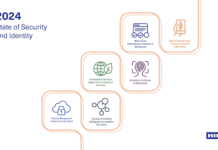By Pat Olsen
From the April 2022 Issue
Surveillance cameras, which have been around for years, provide a number of benefits to protect facilities. Over the years, these devices have become increasingly advanced in their capabilities, and their use has grown considerably. At the same time, they have dropped in price for both live and remote monitoring. Whether or not you are considering an upgrade for your security system, it pays to keep abreast of the opportunities for your organization.

“As a deterrent to crime, there’s really nothing better. They can be a significant force in reducing problems, including vandalism or theft, and are a huge help in encouraging people to behave properly,” says Dean Drako, CEO of Eagle Eye Networks, a cloud video surveillance company.
Over the last several years, a number of changes have occurred, and new features and capabilities have been introduced, including the following industry trends.*
More companies are partnering with cloud providers. Large organizations continue to partner with cloud providers since it’s well accepted that the cloud is the way to go. “Just like your e-mail has moved to Microsoft or Google or another cloud provider, cameras are moving from on-premises recording to cloud recording,” Drako explains. The cloud is lower cost, more reliable because of redundancy, and more secure. It also allows for remote access and maintenance, as well as scalability. “In addition, paying by the month or year means that you don’t have to deal with capital appreciation or the capital expenditure of installing your own system,” he says.
Digital cameras are replacing analog. Drako notes that the surveillance camera industry has been moving towards digital for 10 or 15 years.
Ted Wilkinson, Director of Channel Partners and End Customers at Axis Communications, a leading network camera manufacturer, agrees. “People are still buying and selling analog cameras, but most are buying network (IP) surveillance cameras,” he says.
Some analog HD cameras are actually digital cameras, but they’re marketed as analog HD cameras and are simpler to set up, notes Drako. They’re popular because they run over different wires than digital cameras, and it can be expensive or too difficult to enclose new wires for digital cameras in walls in some buildings, he explains. Thus, facilities that already have the wiring for the analog cameras may end up staying with the analog solution for practicality.
Audio features are gaining in popularity. As people return to workplaces and sites, audio is being introduced on a larger scale. Combined with visual imagery and facial recognition (when allowed), audio can provide notice of a hazardous situation or the presence of an unauthorized person, for example. At that point, audio can play a pre-recorded announcement to evacuate the premises or to be on alert.
Technology has provided a number of advances recently. Axis’ Wilkinson says the last 10 years have really been about technology improvements, and he cites a few examples:
Higher resolution: There’s been a lot of time and energy spent on improving the resolution of cameras. (There are more pixels per inch [PPI] with higher resolution.)
Improved low light performance: When it gets dark out, cameras turn to a black and white image so that you can’t identify the color of a car or shirt, and so forth. Cameras that show color at night are now available.
Specialized cameras: Multi-sensor cameras include one that “sees” a full 360-degree view, which can be helpful in retail, to name one application. Another type of multi-sensor camera has lenses that point in multiple directions, which can help in access control, as another application. “You can have bi-directional audio integrated with a nearby camera and a person can walk up to a loading dock or a front door at the same location and press a button. The person answering the call at the other end can see the person, communicate with them, and decide whether they are to be let in or not,” Wilkinson explains.
AI and analytics continue to be added. “Businesses use surveillance cameras for two applications today. The first is forensics, after an incident, to determine who did what to whom, what broke, or what went wrong. The second, remote monitoring, relates to situational awareness, or what’s occurring in the present. When AI is added, it can be extremely useful for both of these,” Drako notes.
With forensics, AI enhances the search and finds things faster. With remote monitoring, on the other hand, “cameras give you eyes into places where you don’t have a person to watch things. AI is actually doing the work in place of people. There are too many video streams to watch. People get bored. In this case, a computer watches the video stream in their place,” Drako says.
Combining AI and analytics in video surveillance systems not only assists with security, it can also provide business intelligence and be customized to a business’s needs. Consider an example in the retail industry, where a monitoring system with a camera can analyze customer behaviors and traffic patterns. In turn, this can influence store staffing requirements and store layout decisions.
Mark Schreiber, President of Safeguards Consulting and a trainer for the security industry, points out that higher education is another field where surveillance cameras can help with more than security. “Higher education has several business functions on campus, such as the campus store, library, and cafeteria, and can take lessons from different industries or fields to learn how various spaces are being utilized. For example, we’re seeing a trend borrowed from sports venues, where organizations can monitor things like dwell time between vendors,” he says.
Zero Trust Policies are on the rise. Zero Trust Policies are part of a security model where no device, software, or individual is readily trusted. Instead, every user and system trying to gain access to any resource in a network is tested with features like multi-factor authentication, among others. Since cyberattacks show no signs of stopping, organizations are increasingly implementing these policies to reinforce their security systems and protect critical data. Federal agencies are at the forefront of this effort, and facilities in the private sector are not far behind.
*Sources: Axis Communications, Eagle Eye Networks, and Toolbox
Cybersecurity And Securing The Cameras
Schreiber reminds users that surveillance cameras are a double-edged sword. “Once security cameras stopped being CCTV (closed-circuit television) devices—which only required a cable from the camera to a recorder or monitor, and instead connected to a network via IP that uses an Ethernet connection, they opened themselves to nefarious activity,” he says. “Previously, it was difficult to gain access to coaxial cable unless you were physically connected to the cable, but with IP networks, you can be a third-party vendor accessing the camera with an extranet and have the ability to breach the company network,” he warns.

Surveillance cameras provide more capabilities, but they can be attacked more easily. “You protect the cameras through ‘hardening,’ which starts at installation,” Schreiber continues. Hardening is an industry term which means configuring and managing your devices in a way that they’re hard to penetrate from a cyber perspective, Wilkinson explains. One easy way to do this is by using unique passwords and changing them often. Other measures include blocking port connections to the camera itself, limiting the protocols that are used for communicating with the camera, and preventing the camera from reverting to factory default settings after initial setup. Facility managers should also ensure that at predetermined intervals the camera is still properly monitored and the firmware is updated to the latest version, advises Schreiber.
A February 2022 article1 from Axis Communications states: “GDPR (General Data Protection Regulation) compliance and cybersecurity are intrinsically linked,” and the author describes the role of integrators in protecting their customers’ sites and organization overall.
Compliance Issues And Surveillance Operations
Help Net Security, a website focused on information security, predicts that as video surveillance becomes even more widely adopted, as well as used more frequently for compliance purposes, its use will become more regulated.2 “Compliance falls into two categories,” Schreiber says. One is based upon government and market requirements, whether chemical manufacturing or the utilities market, for example.
Within the security market, compliance involves whether surveillance is required in certain areas, and if a video is recorded for a certain timeframe, as well as how (and for how long) information is kept and archived.
The second category relates to privacy, how the cameras are actually being used, how the information is being captured and utilized, and if they’re in line with privacy rights, usually the government’s. “States also have various rights—as well as the European Union—and in that sense, these rights are becoming more market-specific,” says Schreiber.
If organizations are going to tie systems together, with the rapid increase in technological advances, and myriad, complex regulations around access control, Wilkinson suggests they have an integrator on staff. “It’s a specialized skill,” he says. Integrators can do the installation, but they can also tie integrated devices and systems to work together.
Finally, Schreiber notes that under the National Defense Authorization Act (NDAA 2019 Section 889)3, the federal government has banned some video surveillance products used for video surveillance. The Act prohibits the U.S. government from procuring video and telecommunication equipment from certain Chinese companies and their subsidiaries. “The Trade Agreement Act (TAA)4 goes hand in hand with that, specifying that surveillance cameras can only be manufactured in certain countries,” adds Wilkinson.
References
1 https://www.axis.com/blog/secure-insights/cybersecurity-system-integrators/
2 https://www.helpnetsecurity.com/2021/01/06/video-surveillance-trends-2021
3 National Defense Authorization Act (NDAA) – Azure Compliance | Microsoft Docs: https://docs.microsoft.com/en-us/azure/compliance/offerings/offering-ndaa-section-889#ndaa-section-889-overview
4 https://pricereporter.com/taa-trade-agreements-act-compliance-explained/
Olsen writes on business, health, and technology. Her articles and columns have appeared in The New York Times, Family Business, Harvard Business Review, On Wall Street, and others.
Do you have a comment? Share your thoughts in the Comments section below, or send an e-mail to the Editor at acosgrove@groupc.com.





















![[VIDEO] Collect Asset Data at the Speed of Walking a Building](https://facilityexecutive.com/wp-content/uploads/2024/02/maxresdefault-324x160.jpg)